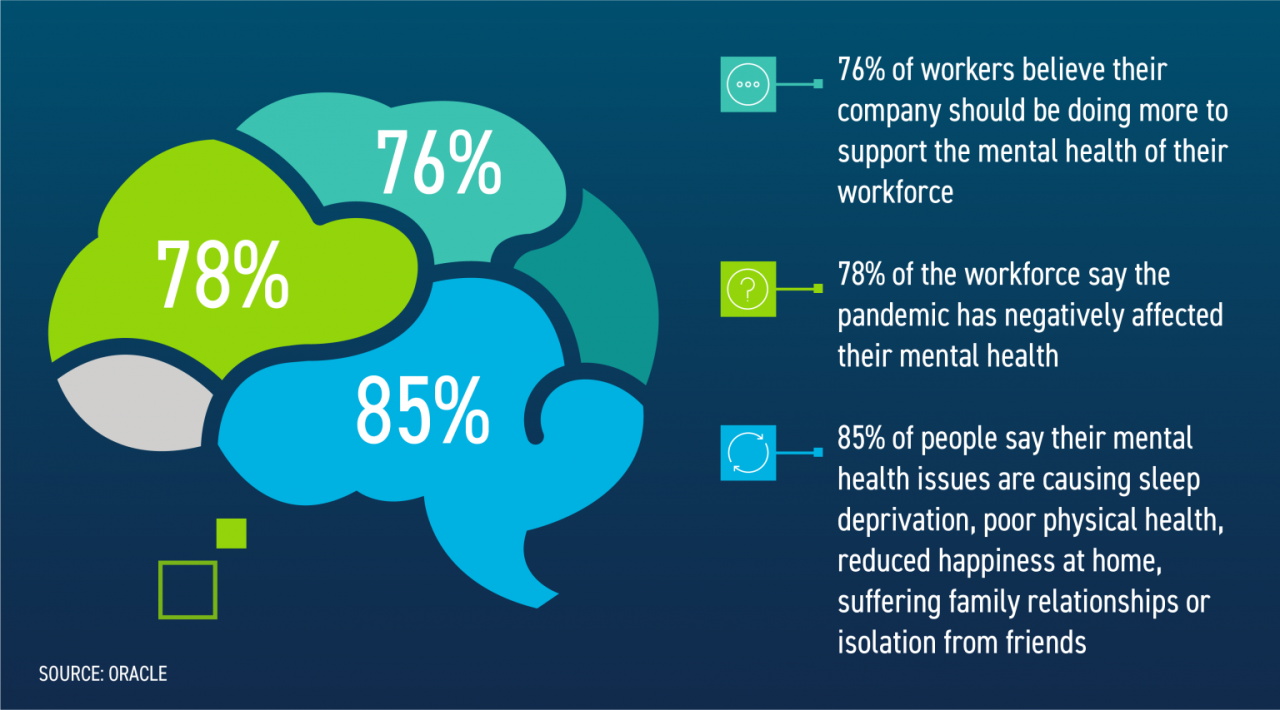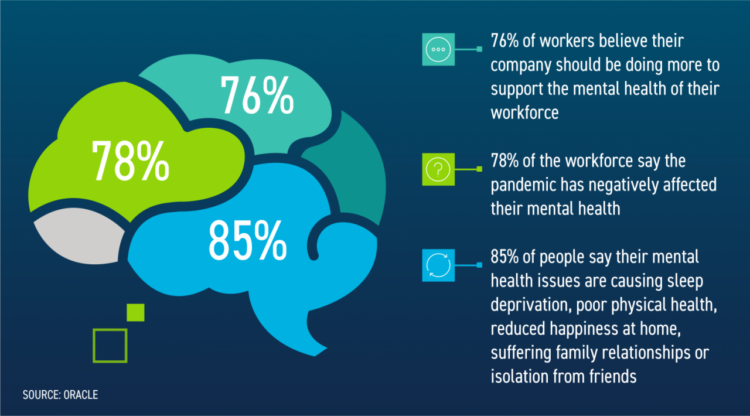
Prevalence and Impact of Mental Health in the Workplace
Mental health issues are prevalent in the workplace, with a significant impact on employee well-being and organizational performance. Studies indicate that a substantial proportion of the workforce experiences mental health challenges, ranging from mild to severe conditions.
The consequences of mental health issues in the workplace are far-reaching. They can lead to reduced productivity, increased absenteeism, and higher turnover rates. Employees struggling with mental health issues may experience difficulty concentrating, making decisions, and interacting with colleagues. This can result in decreased work output and missed deadlines.
Relationship between Mental Health and Workplace Culture
The workplace culture plays a crucial role in shaping the mental health of employees. A positive and supportive work environment can foster mental well-being, while a toxic or stressful culture can contribute to mental health issues. Factors such as workload, job security, and interpersonal relationships can significantly impact employee mental health.
Types of Mental Health Conditions Common in the Workplace
Mental health conditions can manifest in various forms in the workplace, affecting employees’ well-being and productivity. Some common conditions include:
Anxiety Disorders
Anxiety disorders are characterized by excessive worry, fear, and nervousness. Employees with anxiety may experience physical symptoms such as rapid heart rate, sweating, and shortness of breath. They may also avoid certain situations or tasks due to fear or panic.
Depression
Depression is a mood disorder that causes persistent sadness, hopelessness, and loss of interest. In the workplace, employees with depression may exhibit low motivation, difficulty concentrating, and decreased productivity. They may also withdraw from social interactions and experience fatigue.
Stress
Stress is a normal reaction to demanding situations, but prolonged or excessive stress can lead to health problems. Work-related stress can arise from high workloads, deadlines, or conflicts with colleagues. Employees experiencing stress may exhibit irritability, difficulty sleeping, and difficulty concentrating.
Burnout
Burnout is a state of emotional, physical, and mental exhaustion caused by prolonged or excessive stress. Employees with burnout may feel overwhelmed, detached from their work, and have difficulty meeting deadlines. They may also experience physical symptoms such as fatigue, headaches, and digestive problems.
Effects of Mental Health on Workplace Relationships

Mental health conditions can have a significant impact on workplace relationships and team dynamics. Individuals with mental health issues may experience difficulties in communication, collaboration, and conflict resolution. This can lead to misunderstandings, resentment, and a breakdown in trust among colleagues.
Stigma and Discrimination
The stigma surrounding mental health conditions can further exacerbate these challenges. Individuals may be reluctant to disclose their condition due to fear of being judged, ridiculed, or marginalized. This can create a barrier to seeking support and can lead to isolation and loneliness in the workplace.
Fostering an Inclusive Workplace
To address these challenges, it is essential to foster an inclusive and supportive workplace culture. This includes:
- Providing training and education on mental health to reduce stigma and increase understanding.
- Creating a safe and confidential space where employees can discuss mental health concerns.
- Encouraging open communication and active listening to promote empathy and support.
- Implementing flexible work arrangements and support systems to accommodate employees with mental health needs.
- Providing access to mental health resources, such as employee assistance programs and counseling services.
Strategies for Promoting Mental Health in the Workplace
Fostering a mentally healthy workplace is crucial for employee well-being and organizational success. Here are evidence-based strategies to promote mental health in the workplace:
Employer’s Role
- Create a supportive and inclusive work environment where employees feel valued and respected.
- Implement policies and programs that prioritize mental health, such as flexible work arrangements and employee assistance programs.
- Provide training and resources to managers and employees on mental health awareness and support.
Manager’s Role
- Foster open communication and create a safe space for employees to discuss mental health concerns.
- Be aware of signs of mental health issues and provide support and resources as needed.
- Encourage work-life balance and promote healthy work habits.
Employee’s Role
- Take ownership of their mental health by seeking support when needed.
- Practice self-care techniques such as mindfulness, exercise, and healthy eating.
- Support colleagues who may be struggling with mental health issues.
Workplace Initiatives and Programs
- Wellness programs: Offering programs that promote physical, mental, and emotional well-being, such as yoga classes, meditation sessions, and stress management workshops.
- Employee assistance programs (EAPs): Providing confidential counseling, support, and resources to employees and their families.
- Flexible work arrangements: Allowing employees to tailor their work schedules and locations to accommodate their mental health needs.
Legal and Ethical Considerations
In the workplace, employers have legal and ethical obligations to ensure the well-being of their employees, including their mental health. These obligations arise from various laws and ethical principles that protect the rights and dignity of individuals.
Confidentiality and Privacy
Confidentiality and privacy are crucial aspects of handling mental health information. Employers must maintain the confidentiality of employee health records, including mental health information, and protect it from unauthorized access or disclosure. This obligation extends to both physical and electronic records.
Balancing Individual Needs and Organizational Responsibilities
Employers must balance the needs of individuals with the responsibilities of the organization. This includes providing reasonable accommodations for employees with mental health conditions, while also ensuring that workplace safety and productivity are maintained. Employers should engage in an interactive process with employees to determine appropriate accommodations that meet both individual and organizational needs.





